Improving ETa Estimation for Cucurbita moschata Using Remote Sensing-Based FAO-56 Crop Coefficients in the Lis Valley, Portugal
Abstract
1. Introduction
2. Results
2.1. Meteorological Data
2.2. Soil and Water Dynamics
2.2.1. Variation on the Shallow Groundwater Table
2.2.2. SMC and EC
2.2.3. Soil Available Water Content and Storage
2.3. Crop Coefficients and Growing Period Stages
2.4. Evapotranspiration and Crop Water Use
2.5. Satellite-Derived Vegetation Indices During the Growing Season
2.6. Comparison Between Proximal (GreenSeeker®) and Satellite-Derived NDVI
2.7. Calibration of the RS-Assisted Kc-VI Relationship
2.8. Crop Yield and Water Productivity
3. Discussion
3.1. Water Table Fluctuations and Potential Irrigation Effects
3.2. SMC and EC Dynamics
3.3. Growth Phases and Vegetation Index Dynamics
3.4. Calibration of Kc–VI Relationships Across Growth Stages
3.5. Implications of Sensor Geometry and Soil Background on NDVI Accuracy
3.6. Limitations and Final Considerations
4. Materials and Methods
4.1. Description of the Study Site and Agronomic Management


4.2. Soil Moisture and Groundwater
4.3. Agrometeorological Data and Crop Water Use Estimation (FAO-56)
4.4. Satellite Image Acquisition and Pre-Processing
4.5. Vegetation Index Calculation
4.6. Statistical Analysis
5. Conclusions
Author Contributions
Funding
Data Availability Statement
Acknowledgments
Conflicts of Interest
Abbreviations
| AWC | Available water capacity |
| AWS | Soil water storage |
| BIAS | Systematic deviation or bias of model |
| BOA | Bottom-of-atmosphere |
| B2 | Sentinel-2 band 2 |
| B3 | Sentinel-2 band 3 |
| B4 | Sentinel-2 band 4 |
| B8 | Sentinel-2 band 8 |
| C | Conductivity |
| Ca | Calcium |
| CBI | Centre for the Promotion of Imports from Developing Countries |
| CGS | Crop growth stage |
| EC | Electrical conductivity |
| ETa | Actual crop evapotranspiration |
| ETo | Reference evapotranspiration |
| EVI | Enhanced vegetation index |
| F-value | F-statistics for regression significance (ANOVA) |
| fc | Fraction of ground covered by vegetation |
| few | Exposed and wet fraction of the soil that is subject to evaporation |
| fw | Fraction of surface wetted by irrigation |
| FAO-56 | Food and Agriculture Organization |
| FCS | Full crop season |
| G | Gain factor in EVI |
| GCI | Green chlorophyll index |
| GEE | Google Earth Engine |
| I | Irrigation |
| K | Potassium |
| Kc | Crop coefficient |
| Kc_max | Maximum crop coefficient |
| Kcb | Basal crop coefficient |
| Kcb_end | Late-season basal crop coefficient |
| Kcb_ini | Initial stage basal crop coefficient |
| Kcb_mid | Mid-season basal crop coefficient |
| Ke | Soil evaporation coefficient |
| Ls | Soil correction factor in SAVI |
| LVID | Lis Valley Irrigation District |
| Mg | Magnesium |
| N/A | Not available / insufficient data |
| NDVI | Normalized difference vegetation index |
| NIR | Near-infrared reflectance |
| P | Precipitation |
| p-value | Probability value for statistical tests |
| PSU | Practical Salinity Units |
| QGIS | Quantum Geographic Information System |
| R | Resistivity |
| R2 | Coefficient of determination |
| RED | Red reflectance |
| RDO | Dissolved oxygen concentration |
| RHmean | Mean relative humidity |
| RMSE | Root mean square error |
| RS | Remote sensing |
| S | Salinity |
| SAVI | Soil adjusted vegetation index |
| SMC | Soil moisture content |
| SS | Suspended solid concentration |
| TDR | Time domain reflectometry |
| Tmean | Mean air temperature |
| Tmax | Maximum air temperature |
| u2 | Wind speed at 2 m height |
| UAV | Unmanned aerial vehicle |
| VI | Vegetation index |
| WP | Water productivity |
| WUE | Water use efficiency |
References
- Jeffrey, C. Systematics of the Cucurbitaceae: An Overview. In Biology and Utilization of the Cucurbitaceae; Bates, D.M., Robinson, R.W., Jeffrey, C., Eds.; Cornell University Press: Ithaca, NY, USA, 1990; pp. 449–463. [Google Scholar]
- Almeida, D. Manual de Culturas Hortícolas, 3rd ed.; Editorial Presença: Lisboa, Portugal, 2006; Volume I. [Google Scholar]
- Biswas, J.; Kalra, N. Effect of Waterlogging and Submergence on Crop Physiology and Growth of Different Crops and Its Remedies: Bangladesh Perspectives. Saudi J. Eng. Technol. 2018, 3, 315–329. [Google Scholar]
- INE. Agricultural Statistics; INE: Lisbon, Portugal, 2021; Available online: https://www.ine.pt/xportal/xmain?xpid=INE&xpgid=ine_publicacoes&PUBLICACOESpub_boui=439500127&PUBLICACOESmodo=2 (accessed on 11 September 2025).
- Centre for the Promotion of Imports (CBI). The European Market Potential for Pumpkins and Squash. Available online: https://www.cbi.eu/market-information/fresh-fruit-vegetables/pumpkins-and-squash/market-potential (accessed on 15 September 2025).
- Fabeiro, C.; Olalla, F.; Juan, J.A. Production of muskmelon (Cucumis melo L.) under controlled deficit irrigation in a semi-arid climate. Agric. Water Manag. 2002, 54, 93–105. [Google Scholar] [CrossRef]
- Yavuz, D.; Seymen, M.; Yavuz, N.; Çoklar, H.; Ercan, M. Effects of water stress applied at various phenological stages on yield, quality, and water use efficiency of melon. Agric. Water Manag. 2021, 246, 106673. [Google Scholar] [CrossRef]
- Pôças, I.; Calera, A.; Campos, I.; Cunha, M. Remote sensing for estimating and mapping single and basal crop coefficients: A review on spectral vegetation indices approaches. Agric. Water Manag. 2020, 241, 106081. [Google Scholar] [CrossRef]
- French, A.N.; Hunsaker, D.J.; Sanchez, C.A.; Saber, M.; Gonzalez, J.R.; Anderson, R. Satellite-based NDVI crop coefficients and evapotranspiration with eddy covariance validation for multiple durum wheat fields in the US Southwest. Agric. Water Manag. 2020, 241, 106266. [Google Scholar] [CrossRef]
- Wang, T.; Melton, F.S.; Pôças, I.; Johnson, L.F.; Thao, T.; Post, K.; Cassel-Sharma, F. Evaluation of crop coefficient and evapotranspiration data for sugar beets from Landsat surface reflectances using micrometeorological measurements and weighing lysimetry. Agric. Water Manag. 2021, 252, 106533. [Google Scholar] [CrossRef]
- Kooistra, L.; Berger, K.; Brede, B.; Graf, L.V.; Aasen, H.; Roujean, J.-L.; Machwitz, M.; Schlerf, M.; Atzberger, C.; Prikaziuk, E.; et al. Reviews and syntheses: Remotely sensed optical time series for monitoring vegetation productivity. Biogeosciences 2024, 21, 473–511. [Google Scholar] [CrossRef]
- Zhang, X.; Henebry, G.M.; Friedl, M.A.; Schaaf, C.; Ye, Y.; Tran, K.; Liu, L. VIIRS GLSP Algorithm Technical Basis Document, Collection 2.0; NASA Goddard Space Flight Center: Greenbelt, MD, USA, 2024. Available online: https://viirsland.gsfc.nasa.gov/PDF/VIIRS_GLSP-ATBD_V2.pdf (accessed on 17 September 2025).
- Yan, K.; Gao, S.; Yan, G.; Ma, X.; Chen, X.; Zhu, P.; Li, J.; Gao, S.; Gastellu-Etchegorry, J.-P.; Myneni, R.B.; et al. A Global Systematic Review of the Remote Sensing Vegetation Indices. Int. J. Appl. Earth Obs. Geoinf. 2025, 139, 104560. [Google Scholar] [CrossRef]
- Saddik, A.; Latif, R.; Elhoseny, M.; El Ouardi, A. Real-Time Evaluation of Different Indexes in Precision Agriculture Using a Heterogeneous Embedded System. Sustain. Comput. Inform. Syst. 2021, 30, 100506. [Google Scholar] [CrossRef]
- Ferreira, S.; Sánchez, J.M.; Gonçalves, J.M.; Eugénio, R.; Damásio, H. Remote Sensing-Assisted Estimation of Water Use in Apple Orchards with Permanent Living Mulch. Agronomy 2025, 15, 338. [Google Scholar] [CrossRef]
- Allen, R.G.; Pereira, L.S.; Raes, D.; Smith, M. Crop Evapotranspiration—Guidelines for Computing Crop Water Requirements; FAO Irrigation and Drainage Paper 56; FAO: Rome, Italy, 1998. [Google Scholar]
- Park, J.; Baik, J.; Choi, M. Satellite-based crop coefficient and evapotranspiration using surface soil moisture and vegetation indices in Northeast Asia. CATENA 2017, 156, 305–314. [Google Scholar] [CrossRef]
- Taherparvar, M.; Pirmoradian, N. Estimation of Rice Evapotranspiration Using Reflective Images of Landsat Satellite in Sefidrood Irrigation and Drainage Network. Rice Sci. 2018, 25, 111–116. [Google Scholar] [CrossRef]
- Ferreira, S.; Sánchez, J.M.; Gonçalves, J.M. A Remote-Sensing-Assisted Estimation of Water Use in Rice Paddy Fields: A Study on Lis Valley, Portugal. Agronomy 2023, 13, 1357. [Google Scholar] [CrossRef]
- Gontia, N.K.; Tiwari, K.N. Estimation of Crop Coefficient and Evapotranspiration of Wheat (Triticum aestivum) in an Irrigation Command Using Remote Sensing and GIS. Water Resour. Manag. 2010, 24, 1399–1414. [Google Scholar] [CrossRef]
- Lei, H.; Yang, D. Combining the crop coefficient of winter wheat and summer maize with a remotely sensed vegetation index for estimating evapotranspiration in the North China plain. J. Hydrol. Eng. 2014, 19, 243–251. [Google Scholar] [CrossRef]
- Lima, J. Water requirement and crop coefficients of sorghum in Apodi Plateau. Rev. Bras. Eng. Agrícola Ambient. 2021, 25, 684–688. [Google Scholar] [CrossRef]
- Campos, I.; Neale, C.M.U.; Calera, A.; Balbontín, C.; González-Piqueras, J. Assessing satellite-based basal crop coefficients for irrigated grapes (Vitis vinifera L.). Agric. Water Manag. 2010, 98, 45–54. [Google Scholar] [CrossRef]
- Odi-Lara, M.; Campos, I.; Neale, C.M.U.; Ortega-Farías, S.; Poblete-Echeverría, C.; Balbontín, C.; Calera, A. Estimating Evapotranspiration of an Apple Orchard Using a Remote Sensing-Based Soil Water Balance. Remote Sens. 2016, 8, 253. [Google Scholar] [CrossRef]
- Pereira, L.S.; Paredes, P.; Melton, F.; Johnson, L.; Wang, T.; Mota, M.; López-Urrea, R.; Cancela, J.J.; Allen, R.G. Prediction of crop coefficients from fraction of ground cover and height. Background and validation using ground and remote sensing data. Agric. Water Manag. 2020, 241, 106197. [Google Scholar] [CrossRef]
- Pereira, L.S.; Paredes, P.; Hunsaker, D.J.; López-Urrea, R.; Mota, M.; Mohammadi Shad, Z. Standard single and basal crop coefficients for vegetable crops, an update of FAO56 crop water requirements approach. Agric. Water Manag. 2021, 243, 106196. [Google Scholar] [CrossRef]
- Pereira, L.S.; Paredes, P.; Hunsaker, D.J.; López-Urrea, R.; Mohammadi Shad, Z. Standard single and basal crop coefficients for field crops. Updates and advances to the FAO56 crop water requirements method. Agric. Water Manag. 2021, 243, 106466. [Google Scholar] [CrossRef]
- Rallo, G.; Paço, T.; Paredes, P.; Puig, A.; Provenzano, G.; Massai, R.; Pereira, L.S. Updated single and dual crop coefficients for trees and vine crops. Agric. Water Manag. 2021, 250, 106645. [Google Scholar] [CrossRef]
- Pereira, L.S.; Paredes, P.; Melton, F.; Johnson, L.; Mota, M.; Wang, T. Prediction of crop coefficients from fraction of ground cover and height. Practical application to vegetable, field and fruit crops with focus on parameterization. Agric. Water Manag. 2021, 252, 106663. [Google Scholar] [CrossRef]
- Pereira, L.S.; Paredes, P.; Jovanovic, N. Soil water balance models for determining crop water and irrigation requirements and irrigation scheduling focusing on the FAO56 method and the dual Kc approach. Agric. Water Manag. 2020, 241, 106357. [Google Scholar] [CrossRef]
- Garrido-Rubio, J.; González-Piqueras, J.; Campos, I.; Osann, A.; González-Gómez, L.; Calera, A. Remote sensing–based soil water balance for irrigation water accounting at plot and water user association management scale. Agric. Water Manag. 2020, 241, 106236. [Google Scholar] [CrossRef]
- Jovanovic, N.; Pereira, L.S.; Paredes, P.; Pôças, I.; Cantore, V.; Torodovic, M. A review of strategies, methods and technologies to reduce non-beneficial consumptive water use on farms considering the FAO56 methods. Agric. Water Manag. 2020, 241, 106267. [Google Scholar] [CrossRef]
- Minhas, P.S.; Ramos, T.; Ben-Gal, A.; Pereira, L.S. Coping with salinity in irrigated agriculture: Crop evapotranspiration and water management issues. Agric. Water Manag. 2020, 225, 105832. [Google Scholar] [CrossRef]
- IPMA. Resumo Climatológico, Ano 2020; IPMA: Lisbon, Portugal, 2021; Available online: https://www.ipma.pt/resources.www/docs/im.publicacoes/edicoes.online/20200903/aLIMdENsRORErLkagmmX/cli_20200801_20200831_pcl_mm_co_pt.pdf (accessed on 15 December 2024). (In Portuguese)
- Wunsch, A.; Liesch, T.; Goldscheider, N. Towards Understanding the Influence of Seasons on Low-Groundwater Periods Based on Explainable Machine Learning. Hydrol. Earth Syst. Sci. 2024, 28, 2167–2178. [Google Scholar] [CrossRef]
- Konikow, L.F.; Kendy, E. Groundwater Depletion: A Global Problem. Hydrogeol. J. 2005, 13, 317–320. [Google Scholar] [CrossRef]
- Nangia, V.; Oweis, T. Supplemental Irrigation: A Promising Climate-Resilience Practice for Sustainable Dryland Agriculture. In Innovations in Dryland Agriculture; Springer: Cham, Switzerland, 2016; pp. 393–414. [Google Scholar] [CrossRef]
- Molla, T.; Tesfaye, K.; Mekbib, F.; Tana, T.; Taddesse, T. Supplementary Irrigation for Managing the Impact of Terminal Dry Spells on the Productivity of Rainfed Rice (Oryza sativa L.) in Fogera Plain, Ethiopia. Heliyon 2021, 7, e06703. [Google Scholar] [CrossRef]
- Heuvelmans, G.; Louwyck, A.; Lermytte, J. Distinguishing between management-induced and climatic trends in phreatic groundwater levels. J. Hydrol. 2011, 411, 108–119. [Google Scholar] [CrossRef]
- Brito, A.P.; Manzione, R.L.; Wahnfried, I.D. Groundwater dynamics and hydrogeological processes in the Alter do Chão Aquifer: A case study in Manaus, Amazonas—Brazil. Groundw. Sustain. Dev. 2025, 29, 101441. [Google Scholar] [CrossRef]
- Redwan, M.; Rammlmair, D. Simultaneous Monitoring of Water Saturation and Fluid Conductivity in Unconsolidated Sand Columns. Soil Sci. Soc. Am. J. 2010, 74, 1457–1468. [Google Scholar] [CrossRef]
- Wu, M.; Liang, Z.; Peng, M.; Zhao, B.; Li, D.; Zhang, J.; Sun, Y.; Jiang, L. High evaporation rate and electrical conductivity synergistically boosting porous rGO/CNT Film for water evaporation-driven electricity generation. Nano Energy 2023, 116, 108771. [Google Scholar] [CrossRef]
- Zhou, Y.; Wang, X.-S.; Han, P.-F. Depth-Dependent Seasonal Variation of Soil Water in a Thick Vadose Zone in the Badain Jaran Desert, China. Water 2018, 10, 1719. [Google Scholar] [CrossRef]
- O’Donnell, M.S.; Manier, D.J. Spatial Estimates of Soil Moisture for Understanding Ecological Potential and Risk: A Case Study for Arid and Semi-Arid Ecosystems. Land 2022, 11, 1856. [Google Scholar] [CrossRef]
- Schwamback, D.; Persson, M.; Berndtsson, R.; Bertotto, L.E.; Kobayashi, A.N.A.; Wendland, E.C. Automated Low-Cost Soil Moisture Sensors: Trade-Off between Cost and Accuracy. Sensors 2023, 23, 2451. [Google Scholar] [CrossRef]
- Tucker, C.J. Red and Photographic Infrared Linear Combinations for Monitoring Vegetation. Remote Sens. Environ. 1979, 8, 127–150. [Google Scholar] [CrossRef]
- Ziegler, A. Comparison of Violet, Red, and Green Light on Early-Stage Common Bean (Phaseolus vulgaris L.) Development. Ohio J. Sci. 2020, 120, 49. [Google Scholar] [CrossRef]
- Khechba, K.; Belgiu, M.; Laamrani, A.; Stein, A.; Amazirh, A.; Chehbouni, A. The impact of spatiotemporal variability of environmental conditions on wheat yield forecasting using remote sensing data and machine learning. Int. J. Appl. Earth Obs. Geoinf. 2025, 136, 104367. [Google Scholar] [CrossRef]
- Huete, A.R.; Liu, H.Q.; Batchily, K.; Van Leeuwen, W. A Comparison of Vegetation Indices Global Set of TM Images for Estimating Vegetation Properties over a Global Range of Conditions. Remote Sens. Environ. 1997, 59, 246–258. [Google Scholar] [CrossRef]
- Gitelson, A.A.; Kaufman, Y.J.; Merzlyak, M.N. Use of a green channel in remote sensing of global vegetation from EOS-MODIS. Remote Sens. Environ. 1996, 58, 289–298. [Google Scholar] [CrossRef]
- Sims, N.C.; Colloff, M.J. Remote sensing of vegetation responses to flooding of a semi-arid floodplain: Implications for monitoring ecological effects of environmental flows. Ecol. Indic. 2012, 18, 387–391. [Google Scholar] [CrossRef]
- Hassan, M.A.; Yang, M.; Rasheed, A.; Jin, X.; Xia, X.; Xiao, Y.; He, Z. Time-Series Multispectral Indices from Unmanned Aerial Vehicle Imagery Reveal Senescence Rate in Bread Wheat. Remote Sens. 2018, 10, 809. [Google Scholar] [CrossRef]
- López-Urrea, R.; Montoro, A.; Mañas, F.; López-Fuster, P.; Fereres, E. Evapotranspiration and crop coefficients from lysimeter measurements of mature ‘Tempranillo’ wine grapes. Agric. Water Manag. 2012, 112, 13–20. [Google Scholar] [CrossRef]
- Sharma, M.K. Plant Senescence: How Plants Choose, How and When to Die. Int. J. Biochem. Res. Rev. 2023, 32, 40–56. [Google Scholar] [CrossRef]
- Zheng, Y.; Wang, Y.; Aziz, T.; Mamtimin, A.; Li, Y.; Liu, Y. Canopy Chlorophyll Content Inversion of Mountainous Heterogeneous Grasslands Based on the Synergy of Ground Hyperspectral and Sentinel-2 Data: A New Vegetation Index Approach. Remote Sens. 2025, 17, 2149. [Google Scholar] [CrossRef]
- Crespo, N.; Pádua, L.; Paredes, P.; Rebollo, F.J.; Moral, F.J.; Santos, J.A.; Fraga, H. Spatial-Temporal Dynamics of Vegetation Indices in Response to Drought Across Two Traditional Olive Orchard Regions in the Iberian Peninsula. Sensors 2025, 25, 1894. [Google Scholar] [CrossRef] [PubMed]
- Gutiérrez, S.; González-Santiago, J.; Trigo-Córdoba, E.; Rubio-Casal, A.E.; García-Tejero, I.F.; Egea, G. Monitoring of Emerging Water Stress Situations by Thermal and Vegetation Indices in Different Almond Cultivars. Agronomy 2021, 11, 1419. [Google Scholar] [CrossRef]
- Velazquez-Chavez, L.J.; Daccache, A.; Mohamed, A.Z.; Centritto, M. Plant-Based and Remote Sensing for Water Status Monitoring of Orchard Crops: Systematic Review and Meta-Analysis. Agric. Water Manag. 2024, 303, 109051. [Google Scholar] [CrossRef]
- Ippolito, M.; De Caro, D.; Minacapilli, M.; Ciraolo, G.; Provenzano, G. Estimating Crop Coefficients Using Multitemporal Sentinel-2 Remote Sensing Data to Estimate Actual Evapotranspiration of a Citrus Orchard. In Proceedings of the EGU General Assembly, online, 19–30 April 2021; p. EGU21-4650. [Google Scholar] [CrossRef]
- Balbontín, C.; Campos, I.; Odi-Lara, M.; Ibacache, A.; Calera, A. Irrigation Performance Assessment in Table Grape Using the Reflectance-Based Crop Coefficient. Remote Sens. 2017, 9, 1276. [Google Scholar] [CrossRef]
- Potithep, S.; Nagai, S.; Nishida Nasahara, K.; Muraoka, H.; Suzuki, R. Two Separate Periods of the LAI–VIs Relationships Using In Situ Measurements in a Deciduous Broadleaf Forest. Agric. For. Meteorol. 2013, 169, 148–155. [Google Scholar] [CrossRef]
- Paredes, P.; Melo-Abreu, J.; Alves, I.; Pereira, L. Assessing the Performance of the FAO AquaCrop Model to Estimate Maize Yields and Water Use under Full and Deficit Irrigation with Focus on Model Parameterization. Agric. Water Manag. 2014, 144, 81–97. [Google Scholar] [CrossRef]
- Nagalingam, R.; Chintamaneni, V.; Paramasivan, K.; Ponnusamy, M. Smart Agriculture—Automatic Monitoring of Soil Moisture and Irrigation Control for Farming Land. Curr. Agric. Res. 2023, 11, 3. [Google Scholar] [CrossRef]
- Ningi, T.; Mphahlele, M.; Sithole, V.; Manyike, J.Z.; Manganyi, B.; Ngarava, S.; Lubinga, M.H.; Dladla, L.; Molepo, S. Assessment of the Long-Term Impact of Climate Variability on Food Production Systems in South Africa (1976–2020). Climate 2025, 13, 8. [Google Scholar] [CrossRef]
- Smith, M.E.; Bommarco, R.; Vico, G. Rethinking Crop Rotational Benefits Under Climate Change: Beyond the Growing Season. Glob. Change Biol. 2025, 31, e70012. [Google Scholar] [CrossRef]
- Yu, T.; Mahe, L.; Li, Y.; Wei, X.; Deng, X.; Zhang, D. Benefits of Crop Rotation on Climate Resilience and Its Prospects in China. Agronomy 2022, 12, 436. [Google Scholar] [CrossRef]
- European Commission. Local Food and Short Supply Chains. EU Rural Rev. 2012, 1–72. Available online: https://ec.europa.eu/enrd/sites/default/files/E8F24E08-0A45-F272-33FB-A6309E3AD601.pdf (accessed on 15 September 2025).
- Ribeiro, A.L.A.; Maciel, G.M.; Siquieroli, A.C.S.; Luz, J.M.Q.; Gallis, R.B.d.A.; Assis, P.H.d.S.; Catão, H.C.R.M.; Yada, R.Y. Vegetation Indices for Predicting the Growth and Harvest Rate of Lettuce. Agriculture 2023, 13, 1091. [Google Scholar] [CrossRef]
- Kottek, M.; Grieser, J.; Beck, C.; Rudolf, B.; Rubel, F. World Map of the Köppen-Geiger Climate Classification Updated. Meteorol. Z. 2006, 15, 259–263. [Google Scholar] [CrossRef]
- Campar, A.; Gama, A.; Cunha, L.; Jacinto, R.; Boura, I.; Medeiros, J.; Brandão, J. The Lis River Watershed—Contribution to the Study of Territory Organization and Environmental Problems; Câmara Municipal de Leiria, CCDR-Centro: Coimbra, Portugal, 1989. (In Portuguese) [Google Scholar]
- CLIMATE-DATA.ORG. Clima Leiria. Available online: https://pt.climate-data.org/europa/portugal/leiria/leiria-140/ (accessed on 27 November 2024).
- Gonçalves, J.M.; Ferreira, S.; Nunes, M.; Eugénio, R.; Amador, P.; Filipe, O.; Duarte, I.M.; Teixeira, M.; Vasconcelos, T.; Oliveira, F.; et al. Developing Irrigation Management at District Scale Based on Water Monitoring: Study on Lis Valley, Portugal. AgriEngineering 2020, 2, 78–95. [Google Scholar] [CrossRef]
- Ferreira, S.; Oliveira, F.; Gomes da Silva, F.; Teixeira, M.; Gonçalves, M.; Eugénio, R.; Damásio, H.; Gonçalves, J.M. Assessment of Factors Constraining Organic Farming Expansion in Lis Valley, Portugal. AgriEngineering 2020, 2, 111–127. [Google Scholar] [CrossRef]
- Molina, W., Jr. Comportamento Mecânico do Solo em Operações Agrícolas; Universidade Federal de Viçosa: Viçosa, Brazil, 2017. [Google Scholar] [CrossRef]
- Gonçalves, J.M.; Nunes, M.; Ferreira, S.; Jordão, A.; Paixão, J.; Eugénio, R.; Russo, A.; Damásio, H.; Duarte, I.M.; Bahcevandziev, K. Alternate Wetting and Drying in the Center of Portugal: Effects on Water and Rice Productivity and Contribution to Development. Sensors 2022, 22, 3632. [Google Scholar] [CrossRef] [PubMed]
- Odhiambo, L.O.; Irmak, S. Evaluation of the impact of surface residue cover on single and dual crop coefficient for estimating soybean actual evapotranspiration. Agric. Water Manag. 2012, 104, 221–234. [Google Scholar] [CrossRef]
- Saeidi, R. Effect of Planting Date on the Rate of Evaporation and Transpiration Components of Maize under Salinity Stress Conditions. Agronomy 2024, 38, 175–189. [Google Scholar]
- Louis, J.; Debaecker, V.; Pflug, B.; Main-Korn, M.; Bieniarz, J.; Mueller-Wilm, U.; Cadau, E.; Gascon, F. Sentinel-2 Sen2Cor: L2A Processor for Users. In Proceedings of the Living Planet Symposium, Prague, Czech Republic, 9–13 May 2016; Ouwehand, L., Ed.; ESA-SP. ESA: Paris, France, 2016; Volume 740, p. 91, ISBN 978-92-9221-305-3. [Google Scholar]
- Ferreira, S.; Sánchez, J.M.; Gonçalves, J.M.; Eugénio, R.; Damásio, H. Monitoring Eichhornia crassipes and Myriophyllum aquaticum in Irrigation Systems Using High-Resolution Satellite Imagery: Impacts on Water Quality and Management Strategies. AgriEngineering 2025, 7, 151. [Google Scholar] [CrossRef]
- Xue, J.; Su, B. Significant Remote Sensing Vegetation Indices: A Review of Developments and Applications. J. Sens. 2017, 2017, 1353691. [Google Scholar] [CrossRef]
- Justice, C.O.; Vermote, E.; Townshend, J.R.; Defries, R.; Roy, D.P.; Hall, D.K.; Salomonson, V.V.; Privette, J.L.; Riggs, G.; Strahler, A.; et al. The Moderate Resolution Imaging Spectroradiometer (MODIS): Land Remote Sensing for Global Change Research. IEEE Trans. Geosci. Remote Sens. 1998, 36, 1228–1249. [Google Scholar] [CrossRef]

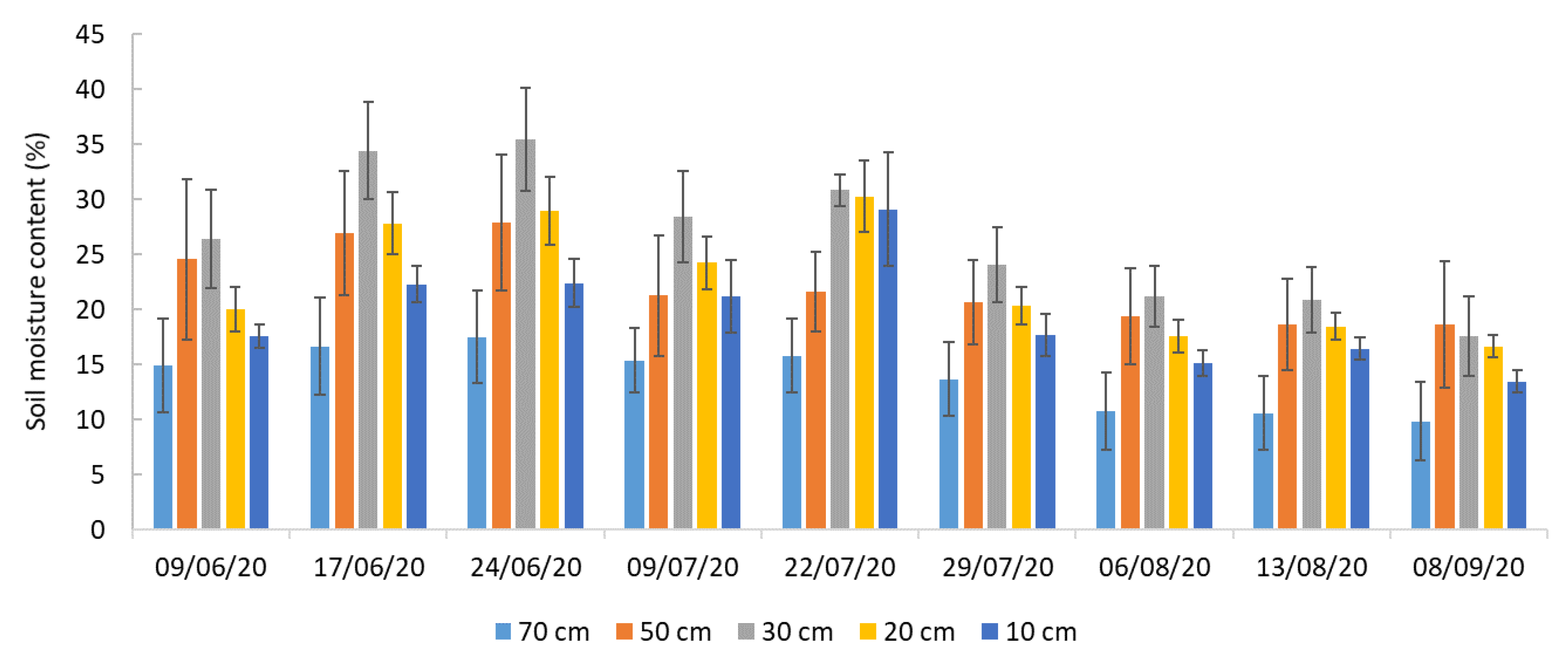
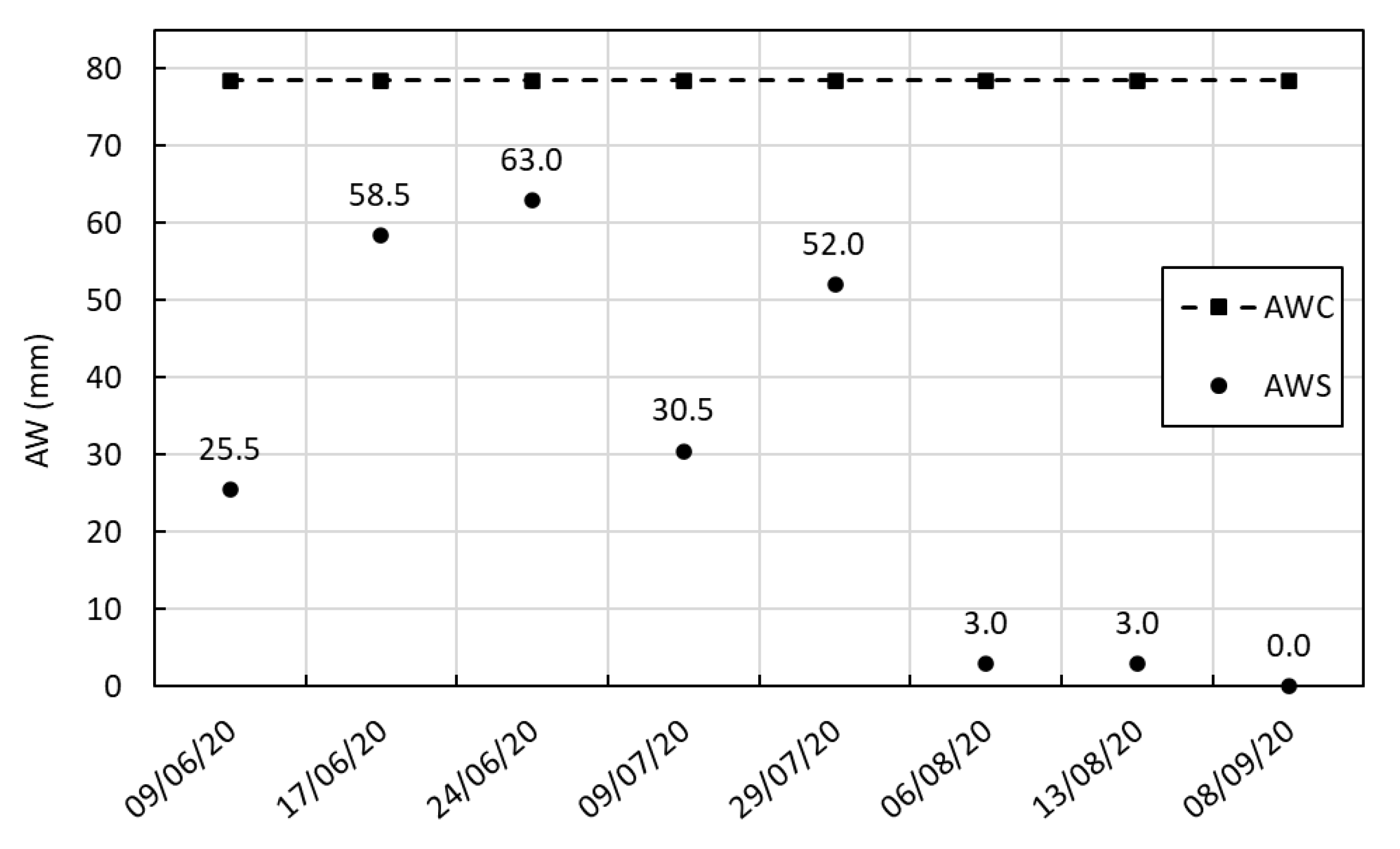

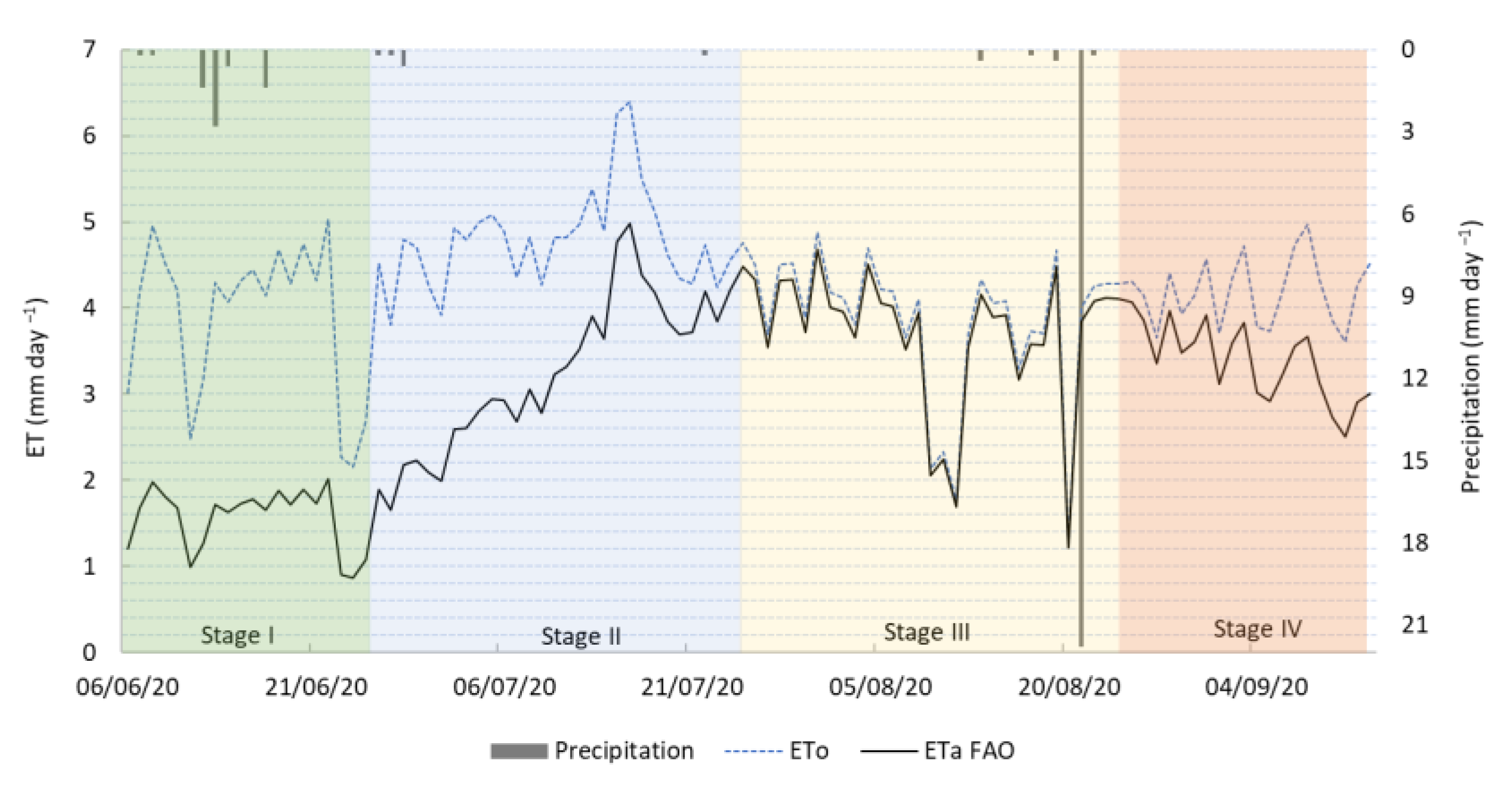
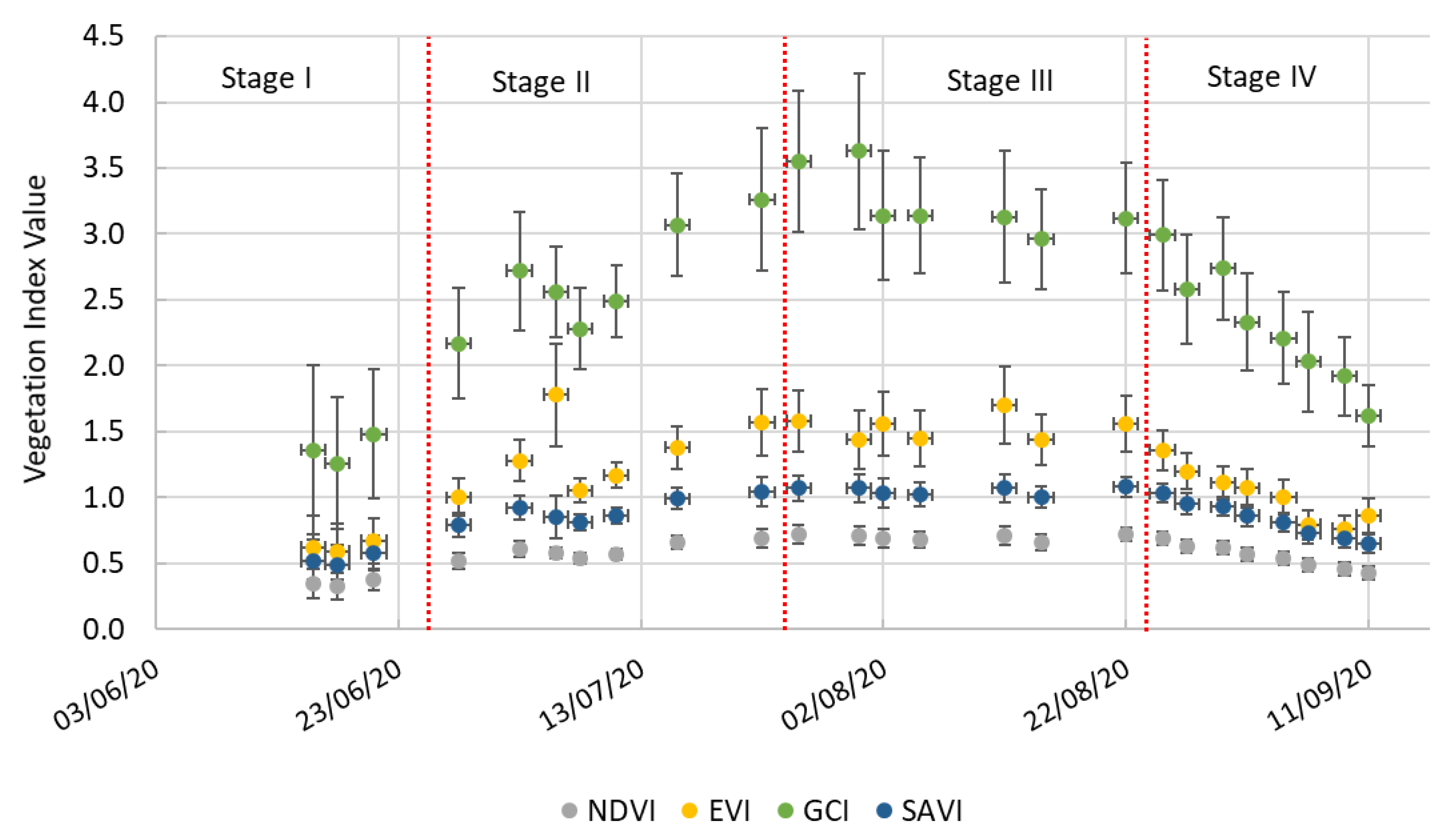

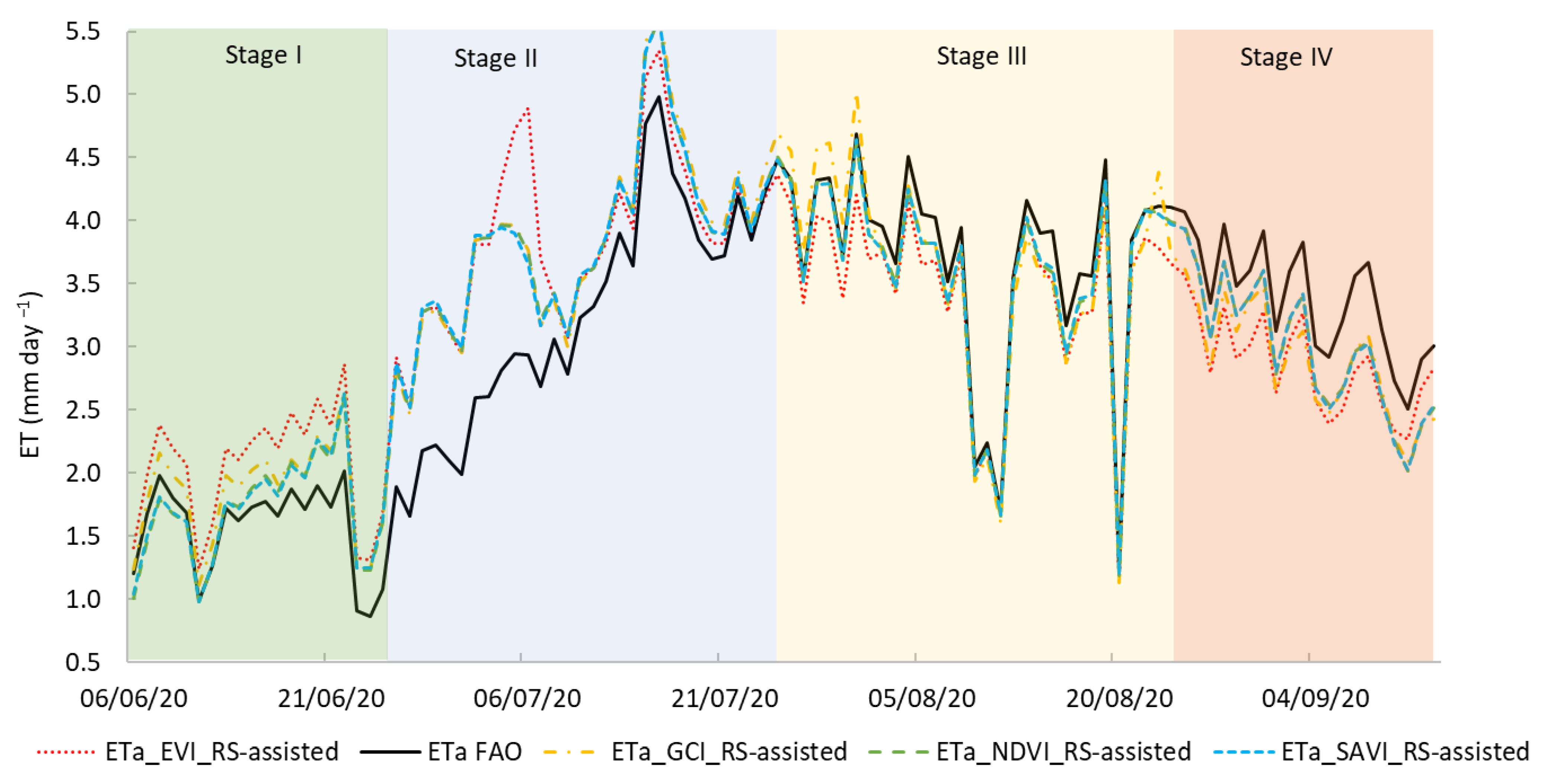

| Season Month | Tmean (°C) | Tmax (°C) | RHmean (%) | Rs (MJ m−2 day−1) | u2 (m s−1) | P (mm) | ETo (mm day−1) |
|---|---|---|---|---|---|---|---|
| June 1 | 17.9 | 23.2 | 81.1 | 22.5 | 1.8 | 7.6 | 4.0 |
| July | 20.7 | 27.7 | 79.5 | 25.3 | 1.6 | 0.2 | 4.8 |
| August | 20.1 | 25.8 | 84.0 | 20.5 | 1.7 | 23 | 3.8 |
| September 2 | 20.1 | 30.7 | 70.5 | 20.4 | 1.3 | 0.2 | 4.1 |
| Average/Total | 19.7 | 26.9 | 78.8 | 22.2 | 1.6 | 31 | 4.2 |
| Date | 70 cm | 50 cm | 30 cm | 20 cm | 10 cm |
|---|---|---|---|---|---|
| 9 June | 1.8 ± 0.3 | 2.7 ± 0.5 | 2.9 ± 0.3 | 2.4 ± 0.2 | 2.1 ± 0.2 |
| 17 June | 1.8 ± 0.3 | 2.7 ± 0.6 | 3.4 ± 0.2 | 2.7 ± 0.2 | 2.5 ± 0.1 |
| 24 June | 1.9 ± 0.2 | 3.0 ± 0.5 | 3.5 ± 0.3 | 2.9 ± 0.3 | 2.6 ± 0.2 |
| 9 July | 2.0 ± 0.2 | 2.7 ± 0.4 | 3.3 ± 0.3 | 2.7 ± 0.3 | 2.5 ± 0.2 |
| 22 July | 1.9 ± 0.2 | 2.8 ± 0.4 | 3.2 ± 0.1 | 2.8 ± 0.2 | 2.7 ± 0.3 |
| 29 July | 2.1 ± 0.2 | 3.0 ± 0.6 | 3.1 ± 0.2 | 2.4 ± 0.1 | 2.3 ± 0.2 |
| 6 August | 1.9 ± 0.2 | 2.8 ± 0.2 | 2.6 ± 0.3 | 2.0 ± 0.3 | 1.9 ± 0.2 |
| 13 August | 1.9 ± 0.3 | 2.8 ± 0.3 | 2.8 ± 0.1 | 2.2 ± 0.2 | 2.1 ± 0.2 |
| 8 September | 1.8 ± 0.1 | 2.8 ± 0.5 | 2.8 ± 0.3 | 2.2 ± 0.2 | 1.8 ± 0.1 |
| Average | 1.90 | 2.79 | 3.07 | 2.48 | 2.28 |
| Pair of Variables | Multiple R | R2 | Std Error | p-Value (X1) | Coef X1 | F-Value (ANOVA) | p-Value (ANOVA) |
|---|---|---|---|---|---|---|---|
| SMC vs. EC 10 cm | 0.942 | 0.89 | 1.718 | <0.001 | 14.04 | 54.86 | <0.001 |
| SMC vs. EC 20 cm | 0.939 | 0.88 | 1.922 | <0.001 | 15.16 | 52.03 | <0.001 |
| SMC vs. EC 30 cm | 0.916 | 0.84 | 2.676 | <0.001 | 19.13 | 36.28 | <0.001 |
| SMC vs. EC 50 cm | 0.123 | 0.02 | 3.705 | 0.75 | −3.76 | 0.11 | 0.75 |
| SMC vs. EC 70 cm | 0.042 | 0.00 | 3.035 | 0.91 | 1.16 | 0.01 | 0.91 |
| CGS | Irrigation | Precipitation | ETo (mm) | ETa (mm) | ||
|---|---|---|---|---|---|---|
| (mm) | (mm) | Daily (mm day−1) | Period (mm) | Daily (mm day−1) | Period (mm) | |
| I | n.d. | 6.8 | 3.9 | 78.0 | 1.6 | 31.2 |
| II | n.d. | 1.0 | 4.8 | 143.8 | 3.3 | 98.4 |
| III | n.d. | 23.0 | 3.8 | 114.9 | 3.7 | 110.3 |
| IV | n.d. | 0 | 4.2 | 83.9 | 3.4 | 67.4 |
| FCS | 450 * | 30.8 | --- | 420.5 | --- | 307.3 |
| Index | Multiple R | R2 | Standard Error | p-Value (Coefficient X1) | Coefficient of X1 | F-Value (ANOVA) | p-Value (ANOVA) |
|---|---|---|---|---|---|---|---|
| NDVI | 0.857 | 0.734 | 0.112 | <0.001 | 1.393 | 66.320 | <0.001 |
| SAVI | 0.857 | 0.735 | 0.112 | <0.001 | 0.930 | 66.542 | <0.001 |
| EVI | 0.707 | 0.500 | 0.153 | <0.001 | 0.405 | 24.012 | <0.001 |
| GCI | 0.821 | 0.674 | 0.124 | <0.001 | 0.245 | 49.577 | <0.001 |
| Index | I | II | III | IV | I + II | I + II + III | II + III | II + III + IV | III + IV |
|---|---|---|---|---|---|---|---|---|---|
| NDVI | N/A | 0.692 | N/A | 0.830 | 0.769 | 0.843 | 0.839 | 0.472 | 0.894 |
| SAVI | N/A | 0.684 | N/A | 0.863 | 0.767 | 0.842 | 0.842 | 0.474 | 0.901 |
| GCI | N/A | 0.702 | N/A | 0.780 | 0.816 | 0.848 | 0.739 | 0.397 | 0.787 |
| EVI | N/A | 0.206 | N/A | 0.784 | 0.620 | 0.700 | 0.371 | 0.184 | 0.789 |
| Vegetation Index | Regression Equation (Kc = a × VI + b) | R2 | RMSE | BIAS |
|---|---|---|---|---|
| NDVI | Kc = 1.393 × NDVI − 0.042 | 0.734 | 0.089 | 0.011 |
| SAVI | Kc = 0.930 × SAVI − 0.044 | 0.735 | 0.086 | 0.005 |
| EVI | Kc = 0.405 × EVI + 0.278 | 0.500 | 0.132 | 0.073 |
| GCI | Kc = 0.245 × GCI + 0.141 | 0.674 | 0.100 | 0.062 |
| Vegetation Index | ETa FAO-56 (mm) | ETa RS-A (mm) | Var. ETa (%) | Y (t ha−1) | WP (kg m−3) | WUE FAO-56 (kg m−3) | WUE RS-A (kg m−3) | Var. WUE (%) |
|---|---|---|---|---|---|---|---|---|
| NDVI | 307.3 | 312.6 | 2.9% | 40 | 8.32 | 0.64 | 0.658 | 2.8% |
| SAVI | 307.3 | 316.4 | 3.0% | 40 | 8.32 | 0.64 | 0.658 | 2.8% |
| GCI | 307.3 | 318.0 | 3.5% | 40 | 8.32 | 0.64 | 0.661 | 3.3% |
| EVI | 307.3 | 317.4 | 3.3% | 40 | 8.32 | 0.64 | 0.660 | 3.2% |
| Crop Growth Stage | Date Range (2020) | Number of Images |
|---|---|---|
| I | 6–25 June | 4 |
| II | 26 June–25 July | 7 |
| III | 26 July–24 August | 7 |
| IV | 25 August–13 September | 8 |
| Total | --- | 26 |
Disclaimer/Publisher’s Note: The statements, opinions and data contained in all publications are solely those of the individual author(s) and contributor(s) and not of MDPI and/or the editor(s). MDPI and/or the editor(s) disclaim responsibility for any injury to people or property resulting from any ideas, methods, instructions or products referred to in the content. |
© 2025 by the authors. Licensee MDPI, Basel, Switzerland. This article is an open access article distributed under the terms and conditions of the Creative Commons Attribution (CC BY) license (https://creativecommons.org/licenses/by/4.0/).
Share and Cite
Ferreira, S.; Sánchez, J.M.; Gonçalves, J.M.; Eugénio, R.; Damásio, H. Improving ETa Estimation for Cucurbita moschata Using Remote Sensing-Based FAO-56 Crop Coefficients in the Lis Valley, Portugal. Plants 2025, 14, 3343. https://doi.org/10.3390/plants14213343
Ferreira S, Sánchez JM, Gonçalves JM, Eugénio R, Damásio H. Improving ETa Estimation for Cucurbita moschata Using Remote Sensing-Based FAO-56 Crop Coefficients in the Lis Valley, Portugal. Plants. 2025; 14(21):3343. https://doi.org/10.3390/plants14213343
Chicago/Turabian StyleFerreira, Susana, Juan Manuel Sánchez, José Manuel Gonçalves, Rui Eugénio, and Henrique Damásio. 2025. "Improving ETa Estimation for Cucurbita moschata Using Remote Sensing-Based FAO-56 Crop Coefficients in the Lis Valley, Portugal" Plants 14, no. 21: 3343. https://doi.org/10.3390/plants14213343
APA StyleFerreira, S., Sánchez, J. M., Gonçalves, J. M., Eugénio, R., & Damásio, H. (2025). Improving ETa Estimation for Cucurbita moschata Using Remote Sensing-Based FAO-56 Crop Coefficients in the Lis Valley, Portugal. Plants, 14(21), 3343. https://doi.org/10.3390/plants14213343









